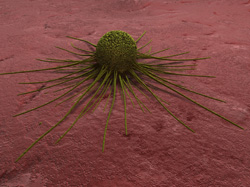Light dynamics for cancer treatment
PDT is an ingenious treatment using a drug – a photosensitiser – that absorbs light of a certain wavelength thereby inducing production of reactive oxygen that in turn kills nearby cells. Specially designed photosensitisers are absorbed by all cells in the body but stay in cancer cells longer. This means that reactive oxygen destroys cancer cells selectively when they are exposed to the appropriate light wavelength. The therapy is suitable for the removal of superficial neoplastic tumours in areas like the head and neck as well as urogenital and gynaecological systems that are inoperable. As the wavelength of the light determines how far the light travels into the body, the technique in principle has huge potential in cancer therapy that only destroys tumour and not healthy cells. An EU-funded project 'Immunophotodynamic therapy of cancer: concepts and applications' (Immuno PDT) aimed to further improve the efficacy of PDT by developing novel photosensitisers that absorb light in the infrared range where light penetration of tissues is maximal. Furthermore, the Immuno PDT team targeted tumour neo-vasculature to close tumour blood vessels thereby destroying many tumour cells dependent on blood supply. Immuno PDT made substantial progress in the development of antibody-based photosensitiser conjugates made up of the photosensitiser bound to an antibody. The researchers synthesised photosensitive molecules that do not stick to unwanted cells and tissues. Novel human antibodies were also isolated for corresponding tumour- associated antigens. Dependent on the antibody and photosensitiser efficiently joining together, Immuno PDT successfully investigated a new method of conjugation. Novel PDT agents have been extensively tested in vitro and in rat models. At close of the project, three of the new antibodies were being manufactured for potential clinical use and eight patent applications had been submitted. Apart from the applications in therapy for otherwise inoperable tumours, there is considerable scope for other treatments under the umbrella of immunotherapy. These include biological treatments for cancers using the body's immune system to fight tumours.

